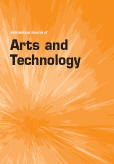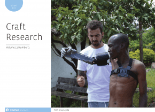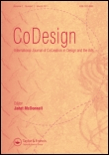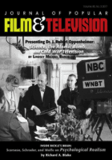
International Journal of Arts and Technology
Scope & Guideline
Fostering collaboration between artists and technologists.
Introduction
Aims and Scopes
- Integration of Technology in Arts:
The journal emphasizes the incorporation of emerging technologies, such as AI, virtual reality, and machine learning, into artistic practices, showcasing how these tools can enhance creativity and artistic expression. - Cultural and Social Impact of the Arts:
Research often explores the role of the arts in cultural identity, social change, and community engagement, particularly in the context of diverse cultural backgrounds and contemporary issues. - Methodological Innovations in Art Research:
The journal promotes innovative research methodologies, including computational models, data analysis, and participatory approaches that contribute to a deeper understanding of artistic phenomena. - Cross-Disciplinary Collaboration:
A core focus is on fostering collaboration among artists, technologists, and researchers from various disciplines to address complex challenges in the arts and technology landscape. - Sustainability in the Arts:
The journal considers how the arts can contribute to sustainable practices and cultural tourism, reflecting on the environmental and economic dimensions of artistic endeavors.
Trending and Emerging
- Digital and Interactive Art Forms:
There is a growing emphasis on digital art and interactive installations, reflecting the increasing integration of technology in artistic practices that engage audiences in novel ways. - Music Technology and Emotion Recognition:
Research on music emotion recognition and the application of AI in music composition is trending, highlighting the intersection of emotional engagement and technological innovation in music. - Cultural Tourism and Technology Post-Pandemic:
Emerging themes include revitalizing cultural tourism through technology, particularly post-COVID-19, as researchers explore how technology can enhance tourism experiences and cultural engagement. - AI and Machine Learning in Art Creation:
The use of AI and machine learning in creating and analyzing artworks is gaining traction, showcasing how these technologies are reshaping artistic production and evaluation. - Sustainable Development through Art:
There is an increasing focus on how art and technology can contribute to sustainable development goals, with research exploring participatory management and urban regeneration linked to the arts.
Declining or Waning
- Traditional Art Forms without Technological Context:
There has been a noticeable decline in research centered solely on traditional art forms that do not integrate technology. As the journal emphasizes innovation, studies that do not explore the influence of technology on these forms are less frequently published. - Static Analysis of Artworks:
Papers that provide only descriptive or static analysis of artworks without incorporating dynamic methodologies or technological frameworks have become less prominent, indicating a shift towards more interactive and technology-driven approaches. - Historical Analysis without Contemporary Relevance:
Research focusing solely on historical contexts of art without linking them to current technological advancements or cultural implications is declining. The journal seems to favor studies that connect past art practices to contemporary challenges. - Non-Interactive Audience Engagement Studies:
There is a waning interest in studies that do not consider audience interaction or engagement with art, particularly in the digital realm. The journal increasingly highlights the importance of audience participation in the artistic experience.
Similar Journals

Craft Research
Unveiling Craft's Rich Tapestry: Insights from Leading ResearchersCraft Research, an esteemed journal published by INTELLECT LTD, serves as a pivotal platform for the exploration and advancement of craft studies within the visual arts and performing arts disciplines. Established in 2014, this journal has made significant contributions to the field, as evidenced by its impressive standing in the Scopus Ranks, where it holds the 88th position out of 667 journals, placing it in the 86th percentile. With a 2023 Category Quartiles ranking of Q2, Craft Research strives to engage researchers, professionals, and students alike, offering a rich repository of peer-reviewed articles that delve into the nuances of craft practice, theory, and criticism. By fostering an interdisciplinary dialogue around craft, the journal aims to elevate the understanding and appreciation of this vital domain of visual culture. For readers interested in the latest research and developments in craft studies, Craft Research stands out as an essential resource, fostering a vibrant community dedicated to the arts.

Artnodes
Advancing Knowledge in Arts, Humanities, and BeyondArtnodes is a prominent academic journal published by UNIV OBERTA CATALUNYA, making significant contributions to the interdisciplinary fields of Arts and Humanities, Cultural Studies, and Computer Science. With an ISSN of 1695-5951 and an E-ISSN of 1695-5951, this Open Access journal has been accessible to the global community since 2002, encouraging the dissemination of innovative research and artistic exploration. Distributed from its headquarters in Barcelona, Spain, Artnodes has established itself as a vital resource, particularly in the domains categorized under Visual Arts, Performing Arts, and Literature, boasting a Q1 ranking in several areas for 2023. The journal is also noted for its impact in computer graphics and design, highlighting the integration of technology and art. With an impressive Scopus rank of #134 in Visual Arts and Performing Arts, this journal remains a critical forum for scholars and practitioners alike, facilitating dialogue and advancing knowledge across disciplines.

De Medio Aevo
Illuminating History and Art Through Scholarly InsightDe Medio Aevo is a distinguished academic journal published by UNIV COMPLUTENSE MADRID, SERVICIO PUBLICACIONES, dedicated to enriching the fields of Cultural Studies, History, Literature and Literary Theory, Philosophy, Religious Studies, and Visual Arts and Performing Arts. Since its inception in 2012 as an Open Access platform, this Spanish journal has rapidly established its reputation, achieving impressive rankings in various categories with a Q1 classification in Literature and Literary Theory and notable positions in Q2 across other fields as per the 2023 metrics. With an emphasis on rigorous scholarly research, De Medio Aevo seeks to foster the exchange of ideas and insights that reflect the rich tapestry of medieval studies and its ongoing impact on contemporary society. It is an essential resource for researchers, professionals, and students alike, encouraging interdisciplinary dialogue and exploration of the cultural narratives that shape our understanding of history and the arts. Located in Madrid, Spain, the journal is committed to making significant contributions to its fields, with a global reach and a focus on academic excellence.

ART JOURNAL
Celebrating the Evolution of Visual and Performing ArtsART JOURNAL, published by Taylor & Francis Inc, is a distinguished journal in the field of Visual Arts and Performing Arts, boasting a commendable Q2 ranking in the latest 2023 category quartiles. With an ISSN of 0004-3249 and E-ISSN 2325-5307, this journal has been a vital platform for artistic discourse since its inception in 1960, detailing a rich lineage of research from 1960 to 1985 and from 1987 to the present. Acknowledged for its pedagogical value and scholarly contributions, the ART JOURNAL ranks #220 out of 667 in the Scopus database, placing it in the 67th percentile among its peers. Despite not currently providing open access options, the journal remains an invaluable resource for researchers, professionals, and students in the arts, fostering an environment for innovative thought and stimulating scholarly exchange.

CoDesign-International Journal of CoCreation in Design and the Arts
Advancing Interdisciplinary Dialogues in Design.CoDesign - International Journal of CoCreation in Design and the Arts is a leading scholarly publication based in the United Kingdom, published by Taylor & Francis Ltd. With a strong emphasis on interdisciplinary collaboration, this journal explores innovative practices in the realms of design and the arts, making significant contributions to the fields of architecture, computer graphics, and performing arts. The journal, devoid of open access options, holds an impressive impact factor reflected in its Q1 rankings across multiple categories including Architecture, Visual Arts, and Computer-Aided Design as of 2023. Furthermore, it has achieved remarkable positions in Scopus rankings, including the 5th percentile in Visual Arts and Performing Arts and the 12th percentile in Architecture, underscoring its influence in the academic community. CoDesign serves as a crucial platform for researchers, professionals, and students eager to engage with contemporary issues and developments within the design and arts sectors, fostering a vibrant exchange of ideas aimed at enriching collaborative practices.

Umeni-Art
Celebrating the Dynamic Dialogue between Art and SocietyUmeni-Art is a prominent journal in the field of visual arts and performing arts, published by the Institute of Art History, Academy of Sciences, Czech Republic. With its ISSN 0049-5123 and E-ISSN 1804-6509, the journal has established itself as a critical platform for scholarly discourse and artistic expression since its inception in 2002. Although currently classified in Q4 within the Arts and Humanities category, it aims to elevate the understanding and appreciation of the arts through rigorous research and innovative perspectives. The journal's Scopus ranking places it at Rank #573/667, reflecting its growing contribution to the field and expanding reach within the artistic community. With a focus on fostering collaboration among researchers, practitioners, and students, Umeni-Art seeks to enrich the academic landscape with significant findings and discussions that inspire future research and creative endeavors. While it does not offer open access, the journal remains a valuable resource for those vested in exploring the dynamic interplay between art, culture, and society in the contemporary context.

Sala Preta
Connecting Scholars and Practitioners in the ArtsSala Preta is a distinguished academic journal published by UNIV SAO PAULO, ESCOLA COMUNICACOES & ARTES, dedicated to the exploration of communication and art in contemporary society. With its ISSN 2238-3867, this journal serves as an essential platform for researchers, professionals, and students to disseminate innovative research and critical analysis in the fields of visual arts, media studies, and cultural communication. Although not classified as Open Access, Sala Preta remains pivotal for fostering academic discourse, encouraging interdisciplinary collaboration, and advancing knowledge within its scope. Situated in the vibrant cultural landscape of São Paulo, Brazil, this journal signifies a commitment to high-quality scholarship that is both relevant and impactful in today's rapidly evolving digital and artistic contexts.

PERFORMANCE RESEARCH
Fostering interdisciplinary insights in the performing arts arena.PERFORMANCE RESEARCH is a distinguished journal published by Taylor & Francis Ltd, dedicated to advancing the field of Visual Arts and Performing Arts. With a significant history dating back to 1996, it provides a critical platform for innovative and interdisciplinary research, promoting dialogue among scholars, practitioners, and students alike. The journal features peer-reviewed articles that explore diverse aspects of performance practice, theory, and criticism, making it a vital resource for those engaged in the creative arts. Recognized as a Q2 journal in its category for 2023 and holding a respectable rank in Scopus, its content is influential in shaping contemporary discussions in performance studies. Although not an open access journal, PERFORMANCE RESEARCH remains accessible through various academic libraries, ensuring the dissemination of knowledge and fostering scholarly communication. Engage with this journal to stay at the forefront of performance research and contribute to the evolving landscape of the arts.

JOURNAL OF POPULAR FILM AND TELEVISION
Transforming Perspectives Through Film and Television Analysis.JOURNAL OF POPULAR FILM AND TELEVISION, published by Routledge Journals, Taylor & Francis Ltd, stands as a significant platform for academic discourse in the realms of cultural studies, visual arts, and performing arts. With its ISSN: 0195-6051 and an evolving digital presence indicated by its E-ISSN: 1930-6458, the journal has carved out a respected niche since its inception in 1978, continuing to contribute to scholarly discussions through 2024. Its impact within the academic community is underscored by a Q3 ranking in Cultural Studies and a Q2 ranking in Visual Arts and Performing Arts for 2023, highlighting its relevance across diverse fields. Notably, with a Scopus ranking placing it in the 74th percentile among visual arts and performing arts journals, it serves as an essential reference point for researchers, professionals, and students committed to the critical examination of film and television. Although not an open-access journal, it provides valuable insights and analysis that enrich understanding of popular media's impact on society. The journal's location in the United States, with a headquarters in Abingdon, England, further affirms its international scope and influence.

Junctures-The Journal for Thematic Dialogue
Cultivating innovative discussions in literature and the arts.Junctures: The Journal for Thematic Dialogue is a distinguished academic platform published by Otago Polytechnic - Te Kura Matatini Ki Otago, based in New Zealand. With the ISSN 1176-5119 and E-ISSN 1179-8912, this journal offers a unique scope that encompasses cultural studies, literature, and the visual and performing arts, providing a critical space for scholars and practitioners to explore interdisciplinary thematic dialogues. Despite being categorized in the lower quartiles of the 2023 Scopus rankings, the journal serves as an important venue for emerging voices in the arts and humanities, facilitating innovative discussions around contemporary cultural issues. While currently not an open access journal, it remains dedicated to fostering scholarly engagement and thought-provoking discourse, enhancing the academic landscape from 2009 to 2012, and again from 2015 to 2020, with a resurgence in 2022 to 2023. Researchers, professionals, and students alike will find in Junctures a valuable resource for advancing the understanding and appreciation of the arts and culture.